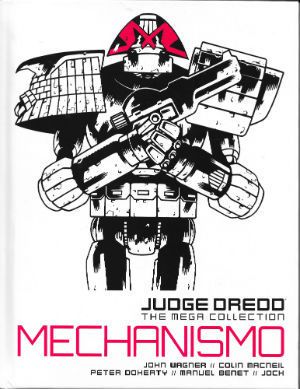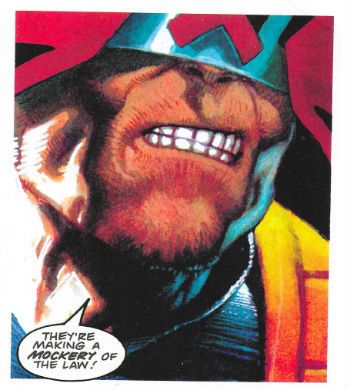“SHUT THEM DOWN! SHUT THEM ALL DOWN!” COMICS! Sometimes He’s Such A Stick In The Mud He’s More Like Judge Ludd!
/In which I provide you with another cheerless slog through a volume of JUDGE DREDD THE MEGA COLLECTION. No charge!
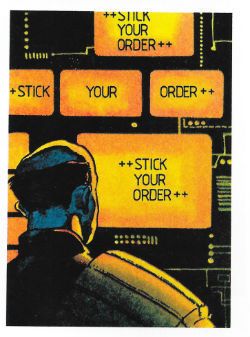 JUDGE DREDD by Doherty, Wagner and Parkhouse
JUDGE DREDD by Doherty, Wagner and Parkhouse
Anyway, this… THE JUDGE DREDD MEGA COLLECTION REVIEW INDEX
MECHANISMO JUDGE DREDD MEGA COLLECTION VOLUME 24 Contents: Introduction by Matt Smith, Mechanismo, Mechanismo Returns, Body Count, S.A.M. and Safe Hands, cover gallery, Colin MacNeil interviewed by Michael Molcher Art by Colin MacNeil, Peter Doherty, Manuel Benet, Val Semeiks & Cliff Robinson, and Jock Written by John Wagner and Gordon Rennie Coloured by Chris Blythe Lettered by Annie Parkhouse and Tom Frame Originally published in Judge Dredd Megazine 2.12. – 2.17, 2.22 – 2.26, 2.37 -2.43, 2000AD progs 1374 and 1273 Hatchette/Rebellion, £6.99 UK (2014) (It’s £6.99 because it was the second issue which is always, in partworks, more expensive than the first issue, but less expensive than the third issue which is when the real price (£9.99) sets in.) Judge Dredd created by Carlos Ezquerra, John Wagner and Pat Mills
I say, I say, I say, when is a comic book movie not a comic book movie? When it is Paul Verhoeven’s Robocop(1987): the best comic book movie ever(1). Yes, smarty pants, despite its not being a comic book movie. Yet, despite its having no direct single original comic book source it opts instead to indulge a cheekily blatant preference to plunder freely from many sources. Mainly though, it plunders from the best; its black humour, satirical edge, ultraviolence and taciturn (but sympathetic) central character all owing more than a little to Judge Dredd(2). In 1993 in the pages of Judge Dredd Megazine(3), no doubt having tired of waiting for acknowledgement or remuneration, John Wagner repaid the favour with Mechanismo; which is basically Judge Dredd vs. Robocop(s)(4). Due to the persistently apocalyptic nature of life in Mega City One Judges are getting a bit short in supply(5). Flying in the face of pretty much every piece of speculative fiction ever in which automata take on human tasks, Justice Department decide to bolster the Judges with automata. Better yet these are fiercely armed, heavily armoured automata with personalities based on Judge Joseph Dredd his own bad self. Dredd thinks this idea is less than ideal but he’s not Chief Judge. McGruder(6) is, so it’s her call. The Mechanismos get a test run and give Dredd a run for his money.
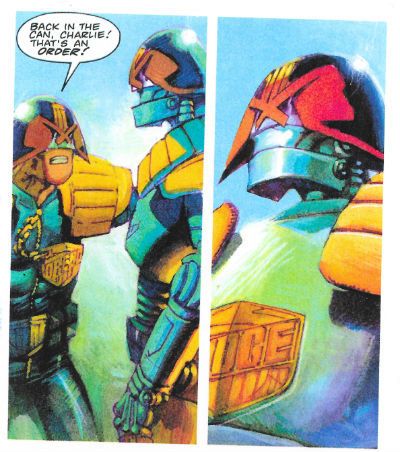 JUDGE DREDD by MacNeil, Wagner and Parkhouse
JUDGE DREDD by MacNeil, Wagner and Parkhouse
Surprising absolutely no one Dredd’s right, and things go wrong about 5 minutes after the droids’ boots hit the slab. People die, chaos puts on its dancing shoes and Dredd soon has to hunt a rogue droid imprinted with his own personality. Um, SPOILER! It’s okay, Mechanismo isn’t really about suspense; Mechanismo is a fleet footed blast of future-thrill action which reads better collected than it did when serialised. Initially these tales seemed a little lightweight for the amount of time it took for them to appear, but here they all are in one chunk and their upside becomes more apparent; what initially starts as a sassy riposte to a cinematic rip off (or homage) develops into something a little deeper(7). Playing Dredd off against his robotic doppelganger(s) is a neat trick since their distorted mirroring of Dredd’s appearance, speech and behaviour is amusing, and their embodiment of his personality unfettered by any humanity is revealing in itself. The Mechanismos aren’t Judge Dredd because they can’t ever be Judge Dredd as they aren’t human, and as little humanity as Dredd may have it’s what ultimately prevents him from becoming a monster. Or at least prevents him from becoming an inhuman monster. As monster’s go Judge Dredd’s a very human one, which is cold comfort but still some comfort. After all, where there’s humanity there’s hope(8).
 JUDGE DREDD by Doherty, Wagner and Parkhouse
JUDGE DREDD by Doherty, Wagner and Parkhouse
Trouble kicks off because the units overheat and start disobeying orders. Or more precisely, they follow orders too inflexibly and are soon executing people for witnessing crimes and not reporting them. Having laws is all well and dandy but justice is about a bit more than that, says the book full of exploding heads and robots that look like killer Metal Mickeys. Tellingly by the end of the trilogy Dredd himself has been forced to do the wrong thing, but for the right reasons. Wagner’s writing takes a misstep here at the last by uncharacteristically labouring what Dredd has done and what it means. However, it is a big step in Dredd’s development(9) so it’s easy to see why Wagner’s usual lightness of touch becomes a little heavier than usual. Pretty much the whole point of robots in stories is that they’ll go wrong(10), or teach us a very special lesson about the magic of human nature(11). Here Wagner gives us both; although because he is John Wagner his very special lesson is a bit less sparkly than most. What starts out as a fast and funny, sunnily lit action romp pivots via a transitionary dank sewer set middle section into a final darkly subdued echo of the initial premise. The cheerful Robocop-esque overkill of the first chapter invites laughter as citizens are slaughtered for ridiculous reasons, but by the final chapter the same jokes have ceased to be played for laughs as the more mordant and downbeat world of Dredd takes precedence over its derivative cinematic would-be usurper.
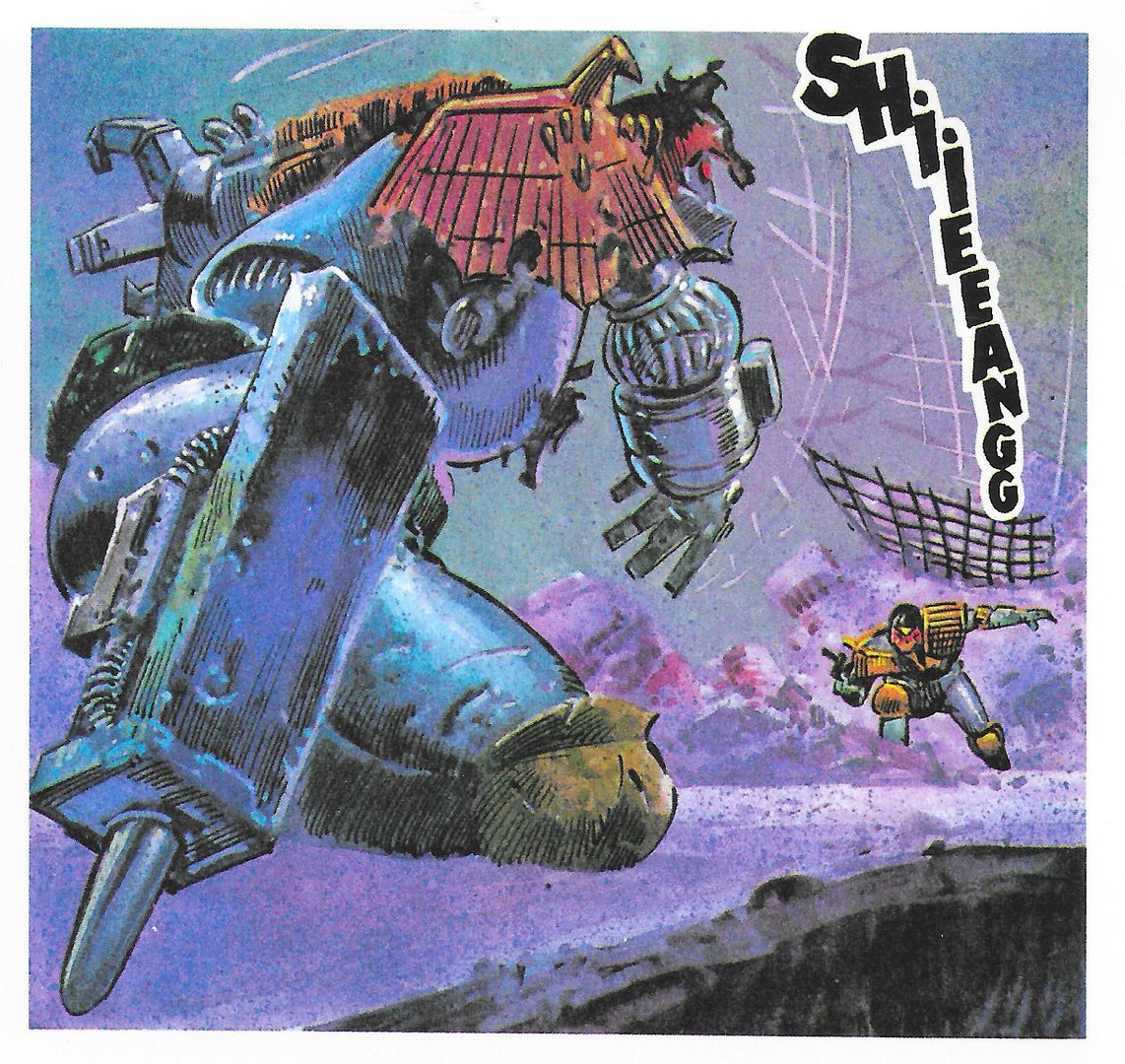 JUDGE DREDD by Benet, Wagner and Frame
JUDGE DREDD by Benet, Wagner and Frame
As ever these strips appeared over a lengthy period of time and the creative teams are (Wagner aside) discrete. Sensibly, visual choppiness over the course of the trilogy is kept to a minimum by assigning each chapter to a particular artist. MacNeil chooses to paint the opener, Mechanismo, in a bleached out style awash with bright sunshine, like it’s perpetually high noon (of course - because there’s a showdown!) Everything has a lovely warm quality - even the smears of colour that were once people’s heads. (12) Signalling the shift in tone Peter Doherty’s Mechanismo Returns is a far darker affair, due to its night time and underground settings. Doherty has an oddly hesitant line, and the resultant tentativeness is an odd fit for the blunt world of Dredd. Also, his people look like they’ve been dead for six months; it’s an odd look all round. I like it, but it’s odd. Not unpleasant, just different(13). In comparison to MacNeil & Doherty Benet’s art on Body Count seems simultaneously both "European" and old fashioned; like a throwback to a 1970s Heavy Metal, or a coloured-in cousin of Casanovas’ work on Dredd (remember Max Normal?) I mean, Benet’s art is fine, it does the job but it can’t help but look a little stuffy and archaic after Doherty and MacNeil’s comparatively brisk and frisky stuff.
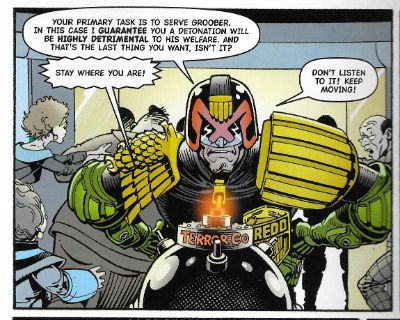 JUDGE DREDD by Semeiks & Robinson, Wagner, Blythe and Frame
JUDGE DREDD by Semeiks & Robinson, Wagner, Blythe and Frame
The book is filled out by a pair of tales falling within the unspoken remit of “robots gone wrong”. In S.A.M. Wagner writes a caustic take on bureaucratic pettifoggery which ostensibly involves Judge Dredd having to outwit a talking bomb, but is given satirical bite via its roots in the plight faced by an increasing number of folk in the real world. The ostensibly bizarre pairing of North American stalwart Semeiks’ pencils with the Bolland-lite inks of Robinson makes for a pleasing goofy result. Robbie Morrison’s Safe Hands is an example of the punchline approach to a Dredd strip and is weak in a probably-had-it-on-file-for-emergencies way. It’s still worth a look because it’s drawn by Jock. And that’s pretty much it. Plenty of Thrill-Power in this volume so Judge Kane’s verdict is a solid GOOD!
They can replace us all with robots but they’ll never replace – COMICS!!!
(1) Yeah, yeah, thinking about it now, Dobermann (1997), Sin City (2005) and Ghost World (2001) are close contenders, and, yeah, sure, you probably have your own favourite but I can’t read your mind, pal, so Robocop wins today (and mostly because I can’t be bothered to do a new opening).
(2) Oh, I’m sure there’s a quote somewhere about how no one involved in the movie had ever heard of Judge Dredd. But still and all, still and all…
(3) The actual issue numbers are up there. That’s one sexy time that is, copying that stuff out. I only do this so I can copy issue numbers out, don’t tell everyone! It’s my Secret Garden!
(4) It’s so obvious I kind of regret taking up all that space building up to such a non-revelation. The first chapter is upfront about it and has a bit of fun directly referring to the Mechanismo as both “the future of law enforcement” and “Robo Judge”. In the second chapter Wagner pokes fun at his own movie allusions with a character declaring “Number 5’s alive!” - the tag line to Short Circuit (1986); a quite different movie from Robocop. No, I haven’t seen Short Circuit; I was 16, why the blue blazes would I be watching a Steve Guttenberg comedy about a tiny robot. I was watching tawdry horror nonsense, probably involving Barbara Crampton screaming. And they let me breed.
(5) This takes place just after NECROPOLIS which had the Dark Judges take over Mega City One with predictably hilarious consequences.
(6) McGruder is a particularly confusing character when encountered in isolated stories. She’s of a distinctly mannish aspect and is functionally nuts, quite often referring to herself in the plural, and prone to paranoid fancies. Originally a Judge who took the Long Walk she returned to the City during NECROPOLIS and was hugely influential in overthrowing the Dark Judges. She means well but her eroding sanity is starting to take its toll. This a sensible footnote. You might want to frame it.
(7) But not that deep. It kind of introduces themes , characters and events which lead into the mega-epic WILDERLANDS which occurs beyond the covers of this book.
(8) You have to believe stuff like that if you have kids, otherwise you go nuts.
(9) Judge Dredd’s that rare character in comics whose character does indeed develop. He also ages and one day he will die. I doubt if he’d want flowers so send the money to a kid’s charity. It’s what he’d want.
(10) See Robocop. Although Robocop goes wrong by regaining his humanity which is right, this is still against his programming so it is also wrong. Look, just go with it.
(11) See Short Circuit. Probably, anyway. Because, no, I don’t know what lesson everyone is supposed to take away from Short Circuit. Like I say I was busy watching From Beyond or something erudite like that. We covered that earlier. Don’t you read these? I have other things to do, you know. I’m not sat around imbibing peeled grapes from servile hands while deigning occasionally to set some words down about Judge Dredd. This country’s turning to shit over here under the Tories, this is not a good time to be conscious and…sorry, 再见了!
(12) In the interview at the back of the book MacNeil explicitly acknowledges this luminous approach, but I’d just like to stress I’d already written about that bit before I’d read his interview. So I’m not stealing his words, I’m saying I was right. That was a pleasant surprise because I’m simply awful on colours.
(13) I’m pretty sure this is the same Peter Doherty who facilitates the excellent colouring on so many of Geoff Darrow’s grotesquely flamboyant creations. I could be wrong, I often am; it’s what keeps me modest.
(14) There is no fourteenth footnote. Go home.


